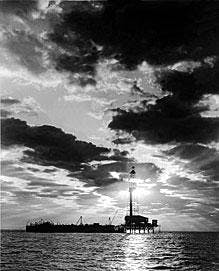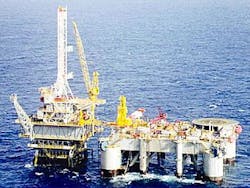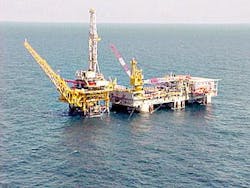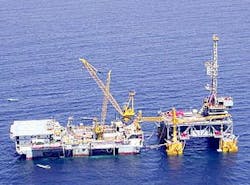Workshop spotlights developments in tender-assisted, deepwater drilling
New technologies that allow operators to step out into deeper water and to drill deeper from shallow water were the focus of the Drilling Engineering Association Workshop recently held in Galveston.
Restructuring the worldwide tender rig fleet, adding newbuilds, and upgrading existing semisubmersibles to tender-assisted drilling rigs, has allowed tender rig operations to move into deep water.
A new, powerful jack up rig design facilitates deep drilling in shallow water. New tubular designs and cementing techniques provide safer, more cost-effective approaches to high pressure, high-temperature (HPHT) drilling.
The "Step Changes in Drilling Technology" conference, held in June, was cosponsored by the US Department of Energy and the US Minerals Management Service and endorsed by the International Association of Drilling Contractors.
Rig 16 on the first well drilled out of sight of land by Kerr-McGee Corp. in November 1947 (Fig. 1; photo from Kerr-McGee Corp.).
Mark Childers of Houston-based Atwood Oceanics Inc. discussed the viability and efficiency of semisubmersible, tender-assisted drilling in deep water. The first-ever semisubmersible tender drilling in deep water occurred in 2003.
The drilling equipment set (DES) required on the fixed or floating platform has a smaller footprint and less weight because it is limited to the derrick and substructure, hoisting traveling equipment, blowout prevention equipment, and solids-control equipment.
The drilling tender contains everything else, including mud systems, storage, power plant, and accommodations. Self-erecting tenders have rig-up cranes and do not require a derrick barge for installation.
The standoff between the platform and the tender vessel is usually only 50 ft, spanned by umbilicals and a walkway.
Childers pointed out that as the load and space requirements on the platform are reduced, the capability to accommodate a larger hook load increases.
Because of the storage capacity on a semi tender (enough for all the materials necessary to drill a deep well), there is little lost time waiting for workboats with less dependence on ocean conditions. The tender can be used as a temporary platform for extended well testing, waterflooding, gas lift, or other operations, and can also serve as a safe haven in the event of an evacuation or emergency.
Mooring systems for semi tenders next to TLPs and spars can be independent (uncoupled) or coupled. Self-moored tenders often have six to eight mooring lines, while a spar might have three mooring legs. Childers said the first coupled mooring, with four spring lines, was accomplished in 2003, by Unocal Makassar Ltd. in the West Seno field coupling the West Alliance semi tender with a TLP.
Tender-assisted drilling dates from Rig 16, drilling in the US Gulf of Mexico 9 miles offshore in Ship Shoal for Kerr-McGee in November 1947, which Childers said was the first tender-supported drilling platform (Fig. 1).
Self-erecting tenders (barges and semis) are now used primarily in Southeast Asia and West Africa. Stavanger-based Smedvig ASA controls half of the world fleet of 22, followed by Pride Foramer SA, a subsidiary of Pride International Inc. (6), Transocean Inc. (4), and Atwood Oceanics Inc. (1). About 17 of the 22 tenders are working in Southeast Asia and the rest in West Africa.
null
Smedvig's West Pelaut semisubmersible drilling tender works off Brunei in November 2003 (Fig. 3; photo from Smedvig ASA).
null
Semi tender fleet
Childers said there are only four self-erecting semi tenders in the world, with a fifth under construction (Smedvig's West Setia); Atwood Oceanics' Seahawk is much larger than the other three semi tenders, in terms of displacement, deck area, operating draft, and air gap.
Built in 1974 and converted to a semi tender in 1992, Seahawk is now an ABS Maltese Cross A1 column stabilized tender drilling unit (Fig. 2). With an all anchor chain mooring system, Seahawk is rated for 600-800 ft water depth.
With a wire rope insert mooring system, it could drill in waters up to 2,000 ft deep. Childers added that with a prelaid semi taut or taut mooring system, the water depth is almost unlimited. The rig has been under contract to ExxonMobil E&P Malaysia Inc. for 12 years and is currently working off Malaysia until Oct. 1, 2004.
The Seahawk was upgraded in 1999 in a Malaysian shipyard, including a new electrical system, a new high rating drilling system, and moving the rig-up crane. Under the terms of the 4-year contract extension, operator ExxonMobil paid $20 million of the approximate $23 million cost of improvements.
Childers proposed building a new semi tender rig, Seascout, with four mud pumps, which could be converted from the semi MODU Ocean Scout. The tender assist concept allows very large savings in construction and installation cost for a TLP or spar in the range of $3-7/lb of variable deck load.
The rest of the world's semisubmersible self-erecting tender rig fleet includes Smedvig's West Pelaut, West Menang, and West Alliance.
The West Pelaut was built in 1994 by Far East Levingston Shipbuilding Ltd.; Smedvig calls it the world's first "new-built" semi tender (Fig. 3). The rig can accommodate a variable deck load of 2,315 tonnes, house 120 people, and work in water between 10 m and 2,000 m deep. The West Pelaut has been under contract to Brunei Shell Petroleum Co. since April 1994, with two interludes to drill for Elf Petroleum Asia (January-February 2000) and for Sarawak Shell Berhad (June-October 2000). The contract with Brunei Shell runs through March 2009.
Smedvig's West Menang was built by Keppel FELS Ltd. in 1999 at a cost of about $100 million. This tender can accommodate the same deck load, personnel, and water depths as the West Pelaut. The West Menang recently finished a 5-year contract with Brunei Shell, April 1999 to April 2004. Smedvig earned a 35 million NOK demobilization fee. The rig is now drilling off Congo, under contract to Total SA until third-quarter 2005, renewable through the end of 2006.
The West Alliance was built in 2001 at a cost of about $85 million (Fig. 4). Although based on the West Menang/ West Pelaut design, this tender has greater deck load capacity (3,300 tonnes), larger accommodations (130), and the ability to drill in both shallow and deep water (up to 6,000 ft with prelaid moorings).
The rig is currently drilling production wells off Indonesia under a 3-year contract with Unocal Makassar Ltd. worth $73 million that began in January 2003. Unocal is the operator of the Makassar Strait production sharing contract (PSC) area, with 50% working interest. Mobil Makassar Inc. holds the remaining 50%. Unocal has the option of releasing the rig after 18 months, and said that it may release the West Alliance this fall.
Smedvig Asia Ltd. announced in early April 2004 that it would build another self-erecting semi tender under an agreement with Keppel FELS in Singapore. The new semi-tender, West Setia, will be a six-column tender similar to the West Alliance but it will feature additional design improvements.
Smedvig will pay $29 million of the $94 million cost of construction, and the rig should be completed by August 2005. Keppel will build the rig and Smedvig will provide drilling equipment, marketing, and management for the first 10 years.
Tong Chong Heong, managing director and chief operating officer of Keppel Offshore and Marine, a subsidiary of Keppel Corp. Ltd., said that the improved motion characteristics and larger variable load capacity and deck space of semi tenders open up "new opportunities for tender rigs to work alongside TLPs and spars" in deep water.
In late April, Smedvig announced that the utilization rate for its tender fleet in first-quarter 2004 was 87%, compared with 96% in fourth-quarter 2003.
Deep drilling, HPHT
Apache Corp.'s Mike Harris moderated a session on high pressure, high-temperature drilling at the DEA Workshop, dealing with rig design, tubular design, and deepwater cementing. The Norwegian Petroleum Directorate defines HPHT wells as having shut-in wellhead pressures of 690 bar (10,000 psi) or higher, and temperatures greater than 150º C. (300º F.).
Eddie Robertson of Rowan Companies Inc. was on the design team for the new Tarzan class rigs and discussed their applicability for deep shelf drilling in the Gulf of Mexico. Rowan's LeTourneau subsidiary put the power of the larger Gorilla rigs in a smaller, less-expensive package, and the new Tarzan design can drill in 15-300 ft water depth.
The Tarzan rig can pump a greater mud volume than the Gorilla class rigs, from six mud pits with two agitators and two slugging pits, using three Lewco 3,000-hp mud pumps, with a maximum pressure of 7,500 psi. On the rig floor, the choke and kill manifold and 183/4-in. BOP system is rated for 15,000-psi working pressure. Five caterpillar engines (Model 3516B HD) are capable of supplying 10,750 hp.
The Tarzan design was constructed with higher-yield steel than Gorilla or 116-C design rigs, resulting in a 10% weight savings. The Tarzan also includes 440-kip opposed pinion jacking units instead of the 375-kip triangular system, allowing jack up with up to 50% preload.
Smedvig's West Alliance semi tender rig, at left, is drilling alongside a tension-leg platform for Unocal Makassar Ltd. off Java (Fig. 4; photo from Smedvig ASA).
null
Rowan has completed building the first of four scheduled Tarzan-class rigs. The Scooter Yeargain was built in Rowan's Letourneau yard in Vicksburg, Miss., christened in Sabine Pass, Tex., on Apr. 3, 2004. It was awarded class certification by the American Bureau of Shipping (ABS) in late April.
According to ABS' Energy News issued June 29, 2004, ABS had already begun the design review of the second Tarzan-class rig, the Bob Keller, currently under construction and expected to be ready for work by September 2005.
U.B. Sathuvalli of Houston-based Blade Energy Partners, discussed extreme HPHT tubular design, which must take into account the compression, burst, tension, and collapse of tubulars. He noted that traditional well construction with conventional technology could accommodate bottomhole static temperatures up to 300º F., although thermal cycling produces large temperature-change effects and stresses tubulars.
New technologies are needed to develop equipment for temperatures greater than 300º F. Ultra-high-temperature wells have bottomhole temperatures even exceeding 425º F.
These extreme temperatures affect elastomers and cause tubulars, drilling fluids, and downhole tool electronics to fail.
Sathuvalli discussed current practices for tubular design down to 24,000-ft TVD and some designs used to 32,000-ft TVD.
He said that standard pipe limits have been defined in the past by API 5C3 (formulas and calculations for casing, tubing, drill pipe, and line pipe properties), but this will be replaced in 2004-05 by the newer ISO 10400 standard (1993, currently under revision). The American Petroleum Institute is moving away from providing and maintaining specifications.
Future engineering analyses will result in the creation of new tubular sizes, grades, and changes in metallurgy.
Blade engineers have designed HPHT wells for clients in California, Norway, and the Middle East, focusing on reducing tubular cost and improving efficiency.
James Griffith discussed finite-element analysis used by Halliburton Co. to design cementing for HPHT wells, using examples from Brazil, West Africa, and the Gulf of Mexico. Halliburton's WellLife service uses a software package to predict the stress regimes of a cement slurry. Griffith also described best practices that should be used to successfully isolate zones in harsh downhole conditions.
Additional sessions at the workshop included downhole tools, drilling fluids, risers, and drilling techniques.





